|
|
|
|
|
|
|
Achi-Kochi Japan
Showing many places to visit and foods to eat in Japan
|
|
|
|
|
|
|
|
|
|
|
|
|
Japan
> Tokai region
> Shirakawa-go
|
|
|
|
|
|
|
Shirakawa-go
Gifu Pref., Tokai ( Achi-Kochi Japan )
|
|
|
|
|
|
|
|
|
|
|
|
|
( "Achi-Kochi" in Japanese means "Here and there" in English. )
Shirakawa-go, Gifu Pref., Tokai region
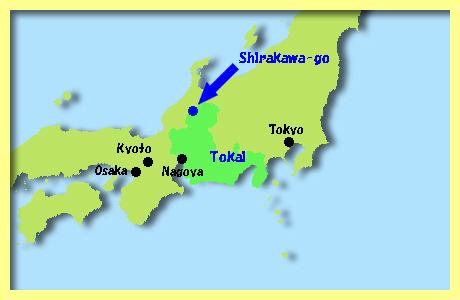
Shirakawa-go ( above ) is a small mountain village located in the north of Gifu Prefecture in the northwest of Tokai Region. Though there is no popular castles nor famous temples in the village, Shirakawa-go is a part of UNESCO World Cultural Heritage Site " Historic Villages of Shirakawa-go and Gokayama " and lots of tourists visit the village.
|
|
Gassho Style Houses - Wada House
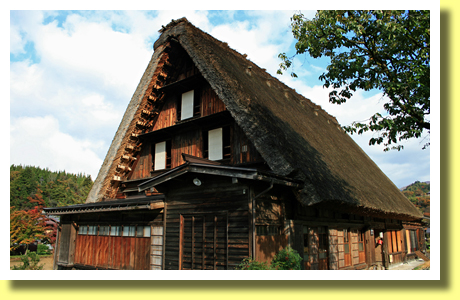
"Gassho" in Japanese means "pressing one's hands together, with palms touching, in prayer". Triangular frame of a thatched roof resembles "Gassho" such as Wada House ( above ). Such buildings are called "Gassho Style Houses" ( or Gassho Zukuri Houses ) including Wada House. Shirakawa-go is very famous for Gassho Style Houses. In the village remain dozens of Gassho Style Houses.
Shirakawa-go is a village surrounded by mountains and its snowfall is so heavy. In such an environment, the design of Gassho Style Houses evolved in the 18th-19th centuries. Some of Gassho Style Houses in Shirakawa-go are more than 250 years old.
|
|
Inside Wada House
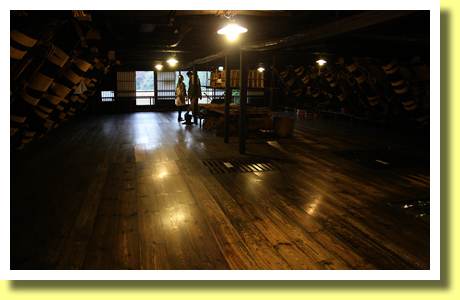
Some parts of Wada House are open to the public. The above photo shows inside the upper storey of the house. Wada House, built more than 200 years ago, is the largest Gassho Style House in Shirakawa-go and one of designated Important Cultural Properties of Japan.
|
|
Tools
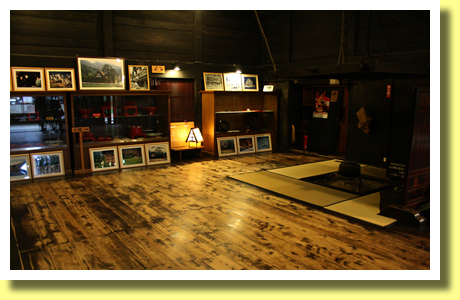
The above photo shows a part of ground floor of Wada House, where traditional tools, which some generations of Wada family had used, are displayed. The Wada family used to be traders of raw silks and explosives and one of the richest in the village.
|
|
Myozen-ji Temple
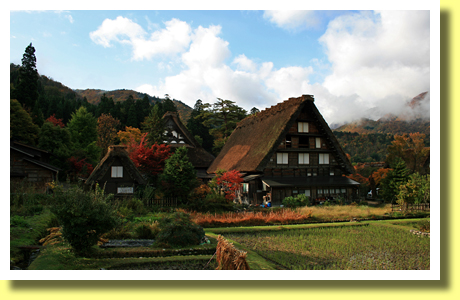
There in Shirakawa-go is Myozen-ji Temple ( above ), which was founded in A.D.1748. There in the site of the temple are a few Gassho Style Houses which were built a few hundreds years ago.
|
|
Kuri of Myozen-ji Temple
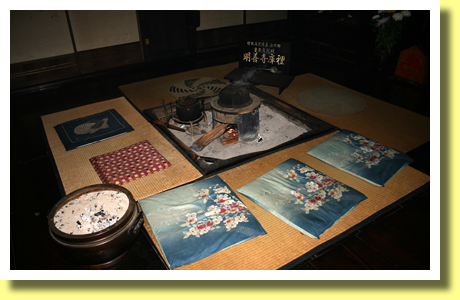
In the site of Myozen-ji Temple, its Kuri ( monk's residence ) is open to the public. Inside Kuri ( above ), tourists could catch a glimpse of their lives. It is said that Kuri was built in A.D.1817 or so.
|
|
Myozen-ji Temple Museum
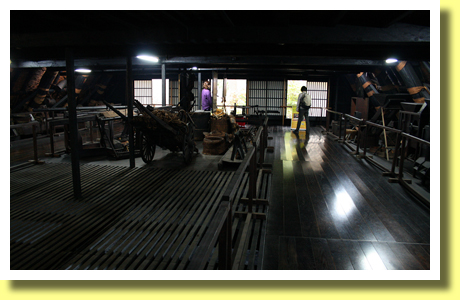
Upper storey of Kuri ( above ) is open to the public as Myozen-ji Temple Museum which exhibits lots of tools which were used a few hundreds years ago.
|
|
Main Hall of Myozen-ji Temple

From the windows of Myozen-ji Temple Museum, tourists could see thatched roof ( above ) of Main Hall of the temple in close. Main Hall, built in A.D.1827, is another one of Gassho Style Houses in the site of the temple. Admission to the museum includes entry to Main Hall, inside which tourists could walk around.
|
|
Landscape
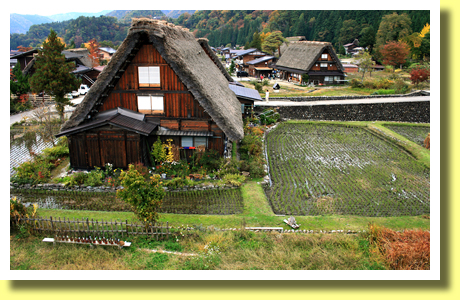
From other windows of Myozen-ji Temple Museum, tourists could enjoy viewing a landscape ( above ) of Gassho Style Houses, paddy fields and forests in Shirakawa-go.
|
|
Gassho Zukuri Minkaen Outdoor Museum

There in Shirakawa-go is Gassho Zukuri Minkaen Outdoor Museum, where a few dozens of Gassho Style Houses are preserved and exhibited including Yoshimori Nakano House ( above ) as well as a shrine, a temple and a watermill.
|
|
Silkworm Raising
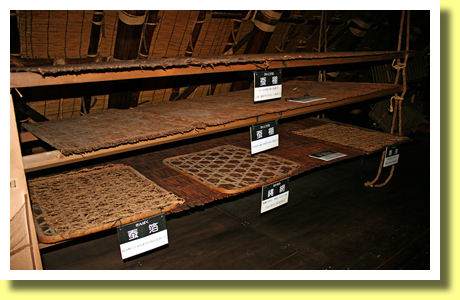
Through Tokugawa Period and Meiji Period, the sericulture had been one of the most important industries in Shirakawa-go. So lots of silkworms had been raised on upper floors in Gassho Style Houses. There are silkworm shelves ( above ) on upper floors of Yoshimori Nakano House, which is preserved in Gassho Zukuri Minkaen Outdoor Museum.
|
|
Maintenance
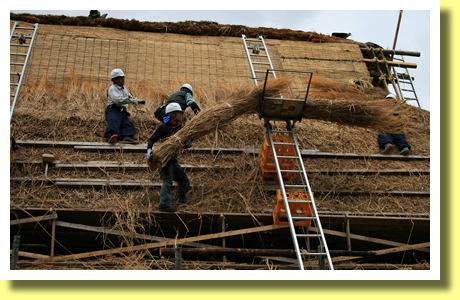
Many people visit Shirakawa-go to see Gassho Style Houses. However maintenance of the houses are far from easy. Snowfall makes thatched roofs need to be repaired every year. In addition, The entire rethatching ( above ) is required once every 30-40 years. Securing materials and experienced manpower for rethatching is a hard task.
|
|
Accommodation

In Shirakawa-go there are more Gassho Style Houses ( above ), some of which offer accommodation as Gassho Style guesthouses, where tourists could experience much more by themselves.
|
|
Ogi-machi Castle Ruin Observation Area
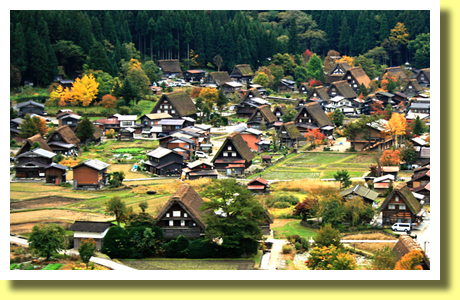
There in Shirakawa-go is Ogi-machi Castle Ruin Observation Area, where tourists could enjoy looking downward to the village and Gassho Style Houses ( above ). It is highly recommended to walk up with a camera to the observation. As for castle ruin, no building remains.
|
|
Hida Beef
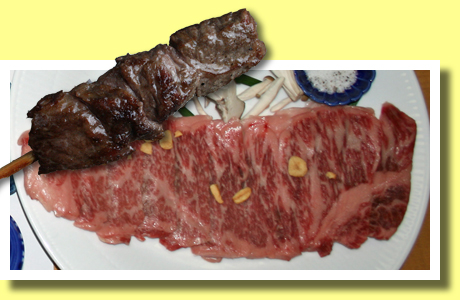
Shirakawa-go is a part of Hida Province, which is the northern part of Gifu Prefecture. Hida Province is famous for Hida Beef ( above ). Steak or Sukiyaki would be so nice. Otherwise there could be shops selling Hida Beef grilled on skewers. Hida beef is one of local specialty dishes in Japan.
|
|
Gokayama
Shirakawa-go is a part of UNESCO World Cultural Heritage Site " Historic Villages of Shirakawa-go and Gokayama " together with Gokayama, which is located in the southwest of Toyama Perfecture, in the east of Hokuriku Region.
|
Copyright (c) 2021 Achi-Kochi Zanmai Co., Ltd.
|